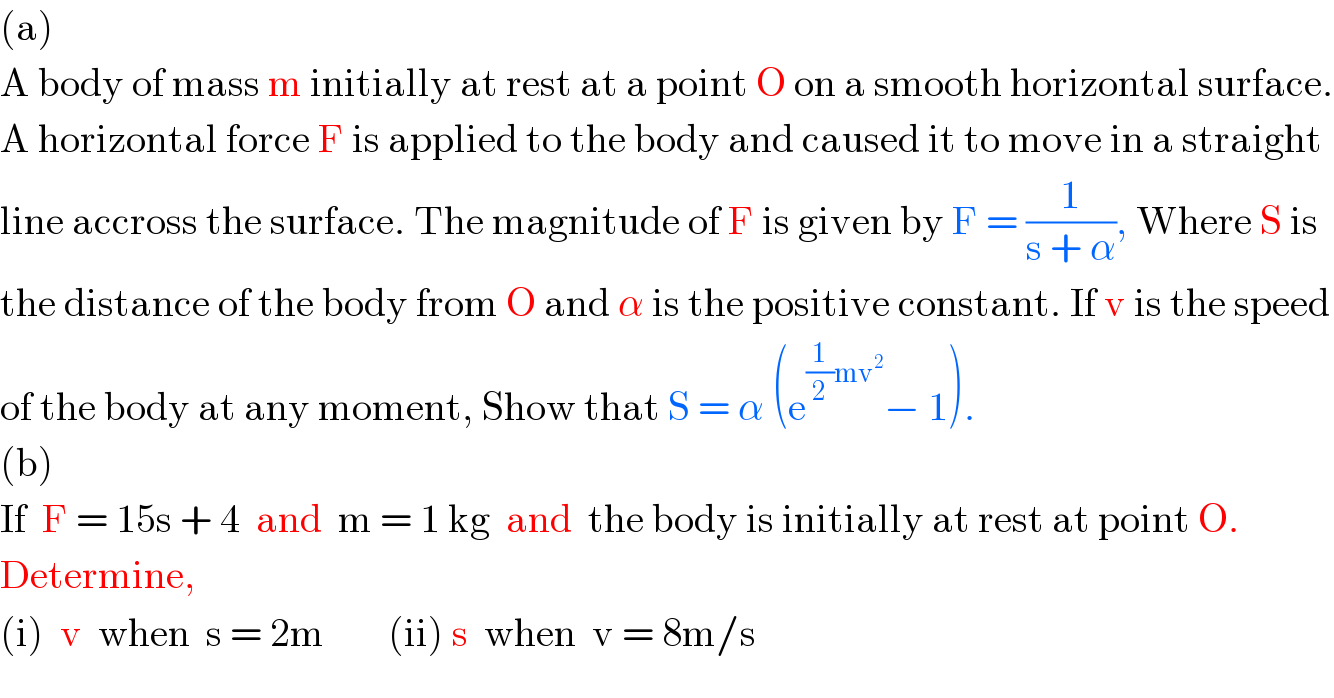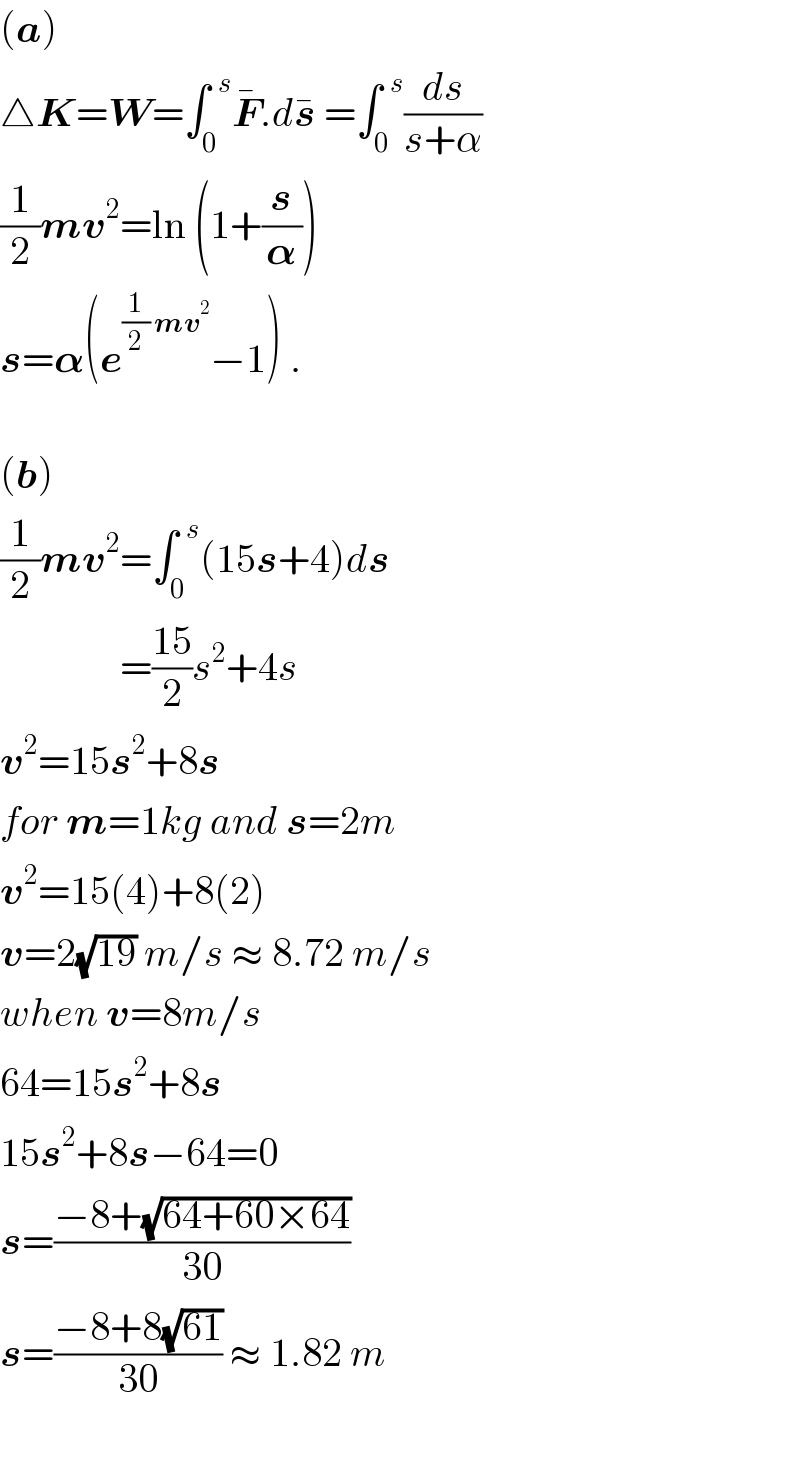
Question Number 13302 by tawa tawa last updated on 17/May/17

$$\left(\mathrm{a}\right) \\ $$$$\mathrm{A}\:\mathrm{body}\:\mathrm{of}\:\mathrm{mass}\:\mathrm{m}\:\mathrm{initially}\:\mathrm{at}\:\mathrm{rest}\:\mathrm{at}\:\mathrm{a}\:\mathrm{point}\:\mathrm{O}\:\mathrm{on}\:\mathrm{a}\:\mathrm{smooth}\:\mathrm{horizontal}\:\mathrm{surface}. \\ $$$$\mathrm{A}\:\mathrm{horizontal}\:\mathrm{force}\:\mathrm{F}\:\mathrm{is}\:\mathrm{applied}\:\mathrm{to}\:\mathrm{the}\:\mathrm{body}\:\mathrm{and}\:\mathrm{caused}\:\mathrm{it}\:\mathrm{to}\:\mathrm{move}\:\mathrm{in}\:\mathrm{a}\:\mathrm{straight} \\ $$$$\mathrm{line}\:\mathrm{accross}\:\mathrm{the}\:\mathrm{surface}.\:\mathrm{The}\:\mathrm{magnitude}\:\mathrm{of}\:\mathrm{F}\:\mathrm{is}\:\mathrm{given}\:\mathrm{by}\:\mathrm{F}\:=\:\frac{\mathrm{1}}{\mathrm{s}\:+\:\alpha},\:\mathrm{Where}\:\mathrm{S}\:\mathrm{is} \\ $$$$\mathrm{the}\:\mathrm{distance}\:\mathrm{of}\:\mathrm{the}\:\mathrm{body}\:\mathrm{from}\:\mathrm{O}\:\mathrm{and}\:\alpha\:\mathrm{is}\:\mathrm{the}\:\mathrm{positive}\:\mathrm{constant}.\:\mathrm{If}\:\mathrm{v}\:\mathrm{is}\:\mathrm{the}\:\mathrm{speed} \\ $$$$\mathrm{of}\:\mathrm{the}\:\mathrm{body}\:\mathrm{at}\:\mathrm{any}\:\mathrm{moment},\:\mathrm{Show}\:\mathrm{that}\:\mathrm{S}\:=\:\alpha\:\left(\mathrm{e}^{\frac{\mathrm{1}}{\mathrm{2}}\mathrm{mv}^{\mathrm{2}} } −\:\mathrm{1}\right).\: \\ $$$$\left(\mathrm{b}\right) \\ $$$$\mathrm{If}\:\:\mathrm{F}\:=\:\mathrm{15s}\:+\:\mathrm{4}\:\:\mathrm{and}\:\:\mathrm{m}\:=\:\mathrm{1}\:\mathrm{kg}\:\:\mathrm{and}\:\:\mathrm{the}\:\mathrm{body}\:\mathrm{is}\:\mathrm{initially}\:\mathrm{at}\:\mathrm{rest}\:\mathrm{at}\:\mathrm{point}\:\mathrm{O}. \\ $$$$\mathrm{Determine}, \\ $$$$\left(\mathrm{i}\right)\:\:\mathrm{v}\:\:\mathrm{when}\:\:\mathrm{s}\:=\:\mathrm{2m}\:\:\:\:\:\:\:\:\left(\mathrm{ii}\right)\:\mathrm{s}\:\:\mathrm{when}\:\:\mathrm{v}\:=\:\mathrm{8m}/\mathrm{s} \\ $$
Answered by mrW1 last updated on 17/May/17

$$\left({a}\right) \\ $$$${F}={ma} \\ $$$${a}=\frac{{dv}}{{dt}}=\frac{{dv}}{{ds}}×\frac{{ds}}{{dt}}={v}\frac{{dv}}{{ds}} \\ $$$${F}=\frac{\mathrm{1}}{{s}+\alpha} \\ $$$$\Rightarrow\frac{\mathrm{1}}{{s}+\alpha}={mv}\frac{{dv}}{{ds}} \\ $$$$\Rightarrow\frac{{ds}}{{s}+\alpha}={mvdv} \\ $$$$\Rightarrow\mathrm{ln}\:\left({s}+\alpha\right)=\frac{\mathrm{1}}{\mathrm{2}}{mv}^{\mathrm{2}} +{C} \\ $$$${at}\:{s}=\mathrm{0},\:{v}=\mathrm{0} \\ $$$$\Rightarrow\mathrm{ln}\:\alpha={C} \\ $$$$\Rightarrow\mathrm{ln}\:\left({s}+\alpha\right)=\frac{\mathrm{1}}{\mathrm{2}}{mv}^{\mathrm{2}} +\mathrm{ln}\:\alpha \\ $$$$\Rightarrow\mathrm{ln}\:\left({s}+\alpha\right)−\mathrm{ln}\:\alpha=\frac{\mathrm{1}}{\mathrm{2}}{mv}^{\mathrm{2}} \\ $$$$\Rightarrow\mathrm{ln}\:\left(\frac{{s}}{\alpha}+\mathrm{1}\right)=\frac{\mathrm{1}}{\mathrm{2}}{mv}^{\mathrm{2}} \\ $$$$\Rightarrow\frac{{s}}{\alpha}+\mathrm{1}={e}^{\frac{\mathrm{1}}{\mathrm{2}}{mv}^{\mathrm{2}} } \\ $$$$\Rightarrow{s}=\alpha\left({e}^{\frac{\mathrm{1}}{\mathrm{2}}{mv}^{\mathrm{2}} } −\mathrm{1}\right) \\ $$$$ \\ $$$$\left({b}\right) \\ $$$${F}={ma}={mv}\frac{{dv}}{{ds}} \\ $$$$\mathrm{15}{s}+\mathrm{4}={v}\frac{{dv}}{{ds}} \\ $$$$\left(\mathrm{15}{s}+\mathrm{4}\right){ds}={vdv} \\ $$$$\frac{\mathrm{1}}{\mathrm{30}}\left(\mathrm{15}{s}+\mathrm{4}\right)^{\mathrm{2}} =\frac{\mathrm{1}}{\mathrm{2}}{v}^{\mathrm{2}} +{C} \\ $$$${at}\:{s}=\mathrm{0},\:{v}=\mathrm{0} \\ $$$$\Rightarrow\frac{\mathrm{16}}{\mathrm{30}}={C} \\ $$$$\frac{\mathrm{1}}{\mathrm{30}}\left(\mathrm{15}{s}+\mathrm{4}\right)^{\mathrm{2}} =\frac{\mathrm{1}}{\mathrm{2}}{v}^{\mathrm{2}} +\frac{\mathrm{16}}{\mathrm{30}} \\ $$$$\left(\mathrm{15}{s}+\mathrm{4}\right)^{\mathrm{2}} =\mathrm{15}{v}^{\mathrm{2}} +\mathrm{16} \\ $$$$\mathrm{15}{v}^{\mathrm{2}} =\left(\mathrm{15}{s}+\mathrm{4}\right)^{\mathrm{2}} −\mathrm{4}^{\mathrm{2}} =\mathrm{15}{s}\left(\mathrm{15}{s}+\mathrm{8}\right) \\ $$$${v}^{\mathrm{2}} ={s}\left(\mathrm{15}{s}+\mathrm{8}\right) \\ $$$$\Rightarrow{v}=\sqrt{{s}\left(\mathrm{15}{s}+\mathrm{8}\right)} \\ $$$$ \\ $$$$\left({i}\right) \\ $$$${s}=\mathrm{2}{m}\Rightarrow{v}=\sqrt{\mathrm{2}\left(\mathrm{30}+\mathrm{8}\right)}=\mathrm{2}\sqrt{\mathrm{19}}=\mathrm{8}.\mathrm{7}\:{m}/{s} \\ $$$$\left({ii}\right) \\ $$$$\mathrm{8}=\sqrt{{s}\left(\mathrm{15}{s}+\mathrm{8}\right)} \\ $$$$\mathrm{15}{s}^{\mathrm{2}} +\mathrm{8}{s}−\mathrm{64}=\mathrm{0} \\ $$$${s}=\frac{−\mathrm{8}+\sqrt{\mathrm{64}+\mathrm{4}×\mathrm{15}×\mathrm{64}}}{\mathrm{2}×\mathrm{15}}=\frac{−\mathrm{4}+\mathrm{4}\sqrt{\mathrm{61}}}{\mathrm{15}}=\mathrm{1}.\mathrm{82}\:{m} \\ $$
Commented by tawa tawa last updated on 18/May/17

$$\mathrm{Wow},\:\mathrm{God}\:\mathrm{bless}\:\mathrm{you}\:\mathrm{sir}.\:\mathrm{I}\:\mathrm{really}\:\mathrm{appreciate}. \\ $$
Answered by ajfour last updated on 18/May/17

$$\left(\boldsymbol{{a}}\right) \\ $$$$\bigtriangleup\boldsymbol{{K}}=\boldsymbol{{W}}=\int_{\mathrm{0}} ^{\:\:{s}} \bar {\boldsymbol{{F}}}.{d}\bar {\boldsymbol{{s}}}\:=\int_{\mathrm{0}} ^{\:\:{s}} \frac{{ds}}{{s}+\alpha} \\ $$$$\frac{\mathrm{1}}{\mathrm{2}}\boldsymbol{{mv}}^{\mathrm{2}} =\mathrm{ln}\:\left(\mathrm{1}+\frac{\boldsymbol{{s}}}{\boldsymbol{\alpha}}\right) \\ $$$$\boldsymbol{{s}}=\boldsymbol{\alpha}\left(\boldsymbol{{e}}^{\frac{\mathrm{1}}{\mathrm{2}}\:\boldsymbol{{mv}}^{\mathrm{2}} } −\mathrm{1}\right)\:. \\ $$$$ \\ $$$$\left(\boldsymbol{{b}}\right) \\ $$$$\frac{\mathrm{1}}{\mathrm{2}}\boldsymbol{{mv}}^{\mathrm{2}} =\int_{\mathrm{0}} ^{\:\:{s}} \left(\mathrm{15}\boldsymbol{{s}}+\mathrm{4}\right){d}\boldsymbol{{s}} \\ $$$$\:\:\:\:\:\:\:\:\:\:\:\:\:\:\:=\frac{\mathrm{15}}{\mathrm{2}}{s}^{\mathrm{2}} +\mathrm{4}{s} \\ $$$$\boldsymbol{{v}}^{\mathrm{2}} =\mathrm{15}\boldsymbol{{s}}^{\mathrm{2}} +\mathrm{8}\boldsymbol{{s}} \\ $$$${for}\:\boldsymbol{{m}}=\mathrm{1}{kg}\:{and}\:\boldsymbol{{s}}=\mathrm{2}{m} \\ $$$$\boldsymbol{{v}}^{\mathrm{2}} =\mathrm{15}\left(\mathrm{4}\right)+\mathrm{8}\left(\mathrm{2}\right) \\ $$$$\boldsymbol{{v}}=\mathrm{2}\sqrt{\mathrm{19}}\:{m}/{s}\:\approx\:\mathrm{8}.\mathrm{72}\:{m}/{s} \\ $$$${when}\:\boldsymbol{{v}}=\mathrm{8}{m}/{s} \\ $$$$\mathrm{64}=\mathrm{15}\boldsymbol{{s}}^{\mathrm{2}} +\mathrm{8}\boldsymbol{{s}} \\ $$$$\mathrm{15}\boldsymbol{{s}}^{\mathrm{2}} +\mathrm{8}\boldsymbol{{s}}−\mathrm{64}=\mathrm{0} \\ $$$$\boldsymbol{{s}}=\frac{−\mathrm{8}+\sqrt{\mathrm{64}+\mathrm{60}×\mathrm{64}}}{\mathrm{30}} \\ $$$$\boldsymbol{{s}}=\frac{−\mathrm{8}+\mathrm{8}\sqrt{\mathrm{61}}}{\mathrm{30}}\:\approx\:\mathrm{1}.\mathrm{82}\:{m} \\ $$$$\: \\ $$
Commented by tawa tawa last updated on 18/May/17

$$\mathrm{God}\:\mathrm{bless}\:\mathrm{you}\:\mathrm{sir}.\:\mathrm{i}\:\mathrm{really}\:\mathrm{appreciate}. \\ $$
Commented by mrW1 last updated on 18/May/17

$${wonderful}! \\ $$
